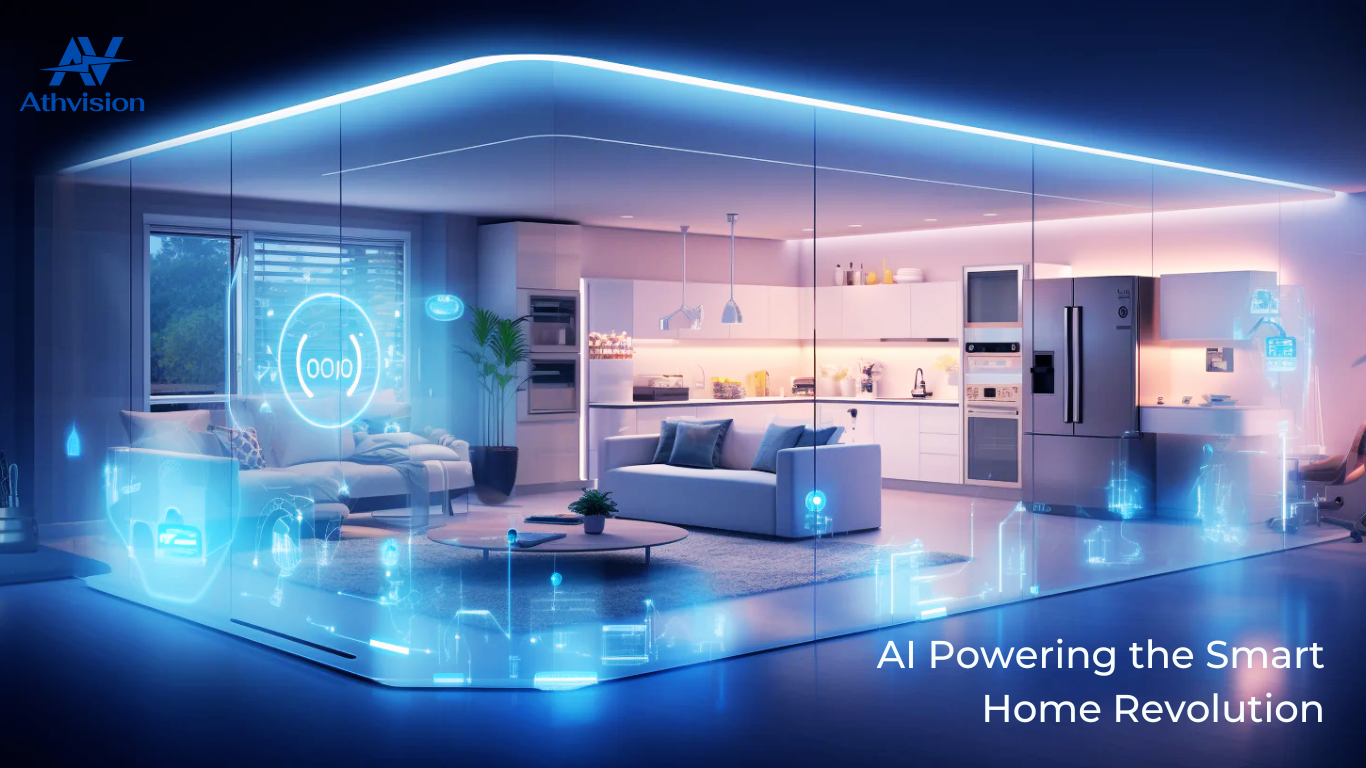The concept of the “smart home” has evolved from a futuristic dream into a present-day reality, with homes now brimming with connected devices that make life more convenient, efficient, and secure. Central to this transformation is artificial intelligence (AI), which is not only powering these devices but also revolutionizing how we interact with our living spaces. AI enables homes to learn from their occupants, anticipate needs, and provide personalized experiences that were once unimaginable. This article delves into how AI is driving the smart home revolution, reshaping the way we live.
The Smart Home Revolution
The smart home revolution is not just an incremental step forward in home automation—it represents a complete transformation of how we live. What sets this revolution apart is the integration of a vast ecosystem of connected devices that communicate with one another to provide a seamless user experience. This evolution goes beyond merely controlling gadgets remotely; it enables homes to anticipate needs, adapt to personal preferences, and enhance overall convenience and security.
According to a Statista report, the number of smart homes globally is projected to exceed 350 million by 2025, highlighting the rapid adoption of this technology. This surge in smart home integration underscores both the increasing accessibility of these devices and their significant role in improving quality of life. The smart home revolution is about more than just convenience—it’s about creating an environment that proactively responds to its inhabitants’ habits and preferences, making daily life more efficient, comfortable, and personalized.
The Role of AI in Smart Homes
AI plays a pivotal role in the smart home revolution, serving as the intelligence that allows devices to operate autonomously and adapt to user behavior. Without AI, smart homes would be limited to simple remote-controlled gadgets. It is AI that enables these devices to learn from user habits, anticipate needs, and optimize their performance accordingly.
A prime example of AI’s transformative impact is the use of AI-powered thermostats, which learn household temperature preferences over time and automatically adjust settings for maximum comfort and energy efficiency. This adaptive behavior highlights AI’s ability to enhance convenience without manual input, as machine learning algorithms analyze data to provide personalized experiences.
AI’s influence extends beyond individual devices to entire smart home ecosystems. Platforms like Google Home and Amazon Alexa serve as central hubs, allowing AI to coordinate communication between various smart devices. This interconnectedness creates a seamless, automated experience—homes can automatically adjust lighting, lock doors, and activate security systems based on user routines, all orchestrated by AI.
AI’s strength lies in its ability to process large volumes of data from multiple sources—such as thermostats, lights, security cameras, and appliances—and use that information to make intelligent decisions. AI-powered lighting systems, for instance, can detect room occupancy and adjust brightness accordingly, reducing unnecessary energy consumption.
Personalized Automation: Tailoring Home Experiences
One of the most exciting aspects of AI in smart homes is its ability to personalize the user experience. Unlike traditional automation, where actions are pre-programmed and rigid, AI systems adapt to the preferences and behaviors of the residents.
For example, AI-enabled virtual assistants like Amazon’s Alexa or Google Assistant can manage various home functions based on voice commands, but more impressively, they learn over time. They can remember your music preferences, suggest the best times to adjust lighting or heating, and even schedule routines based on your daily habits. As AI continues to evolve, the smart home becomes more personalized, anticipating needs before they are expressed.
AI-Powered Smart Home Devices
The variety of AI-powered smart home devices available today is astounding. Each device, whether it be a smart speaker, a vacuum cleaner, or a home security system, leverages AI to offer features that go far beyond traditional counterparts.
Take smart speakers, for instance. Devices like Amazon Echo and Google Nest are not just speakers; they are virtual assistants capable of controlling other smart home devices, providing real-time information, and learning user preferences to deliver a personalized experience. I recall the first time my smart speaker suggested a playlist based on my mood, a subtle yet powerful demonstration of AI’s potential.
Smart security systems are another area where AI shines. These systems utilize facial recognition technology to differentiate between familiar and unfamiliar faces, reducing false alarms and enhancing home security. A friend of mine recently installed one and was amazed by its ability to notify him of unexpected visitors while recognizing his family members. This capability is a testament to the sophistication of AI algorithms that can process and analyze data in real-time.
Even mundane tasks like cleaning have been revolutionized by AI with the advent of robotic vacuum cleaners. These devices use AI to map out floor plans, detect obstacles, and optimize cleaning routes, making them far more efficient than traditional vacuum cleaners.
Enhancing Security with AI
Home security has seen significant advancements with the integration of AI. Traditional security systems typically rely on motion detectors or door/window sensors to alert homeowners of potential breaches. However, AI-powered security systems offer far more sophisticated protection.
Smart cameras equipped with AI-based facial recognition can distinguish between known family members, delivery personnel, and potential intruders. These systems can notify homeowners immediately of suspicious activities while minimizing false alarms. AI can also analyze footage in real time, detecting abnormal behavior patterns that may indicate a security threat.
Additionally, AI-driven security solutions can integrate with other smart devices, such as door locks and lighting systems, to create automated responses. For example, if a security camera detects suspicious movement outside, AI can trigger outdoor lights to turn on, and lock all doors and windows, creating an extra layer of protection.
Energy Efficiency and Sustainability
Another major contribution of AI to the smart home revolution is in the realm of energy efficiency and sustainability. By optimizing the use of energy-consuming devices, AI helps homeowners reduce their carbon footprint and lower energy bills.
AI-powered systems can adjust heating, cooling, and lighting based on occupancy patterns, time of day, and even the weather forecast. For instance, AI can lower the thermostat when it knows the house will be empty, or it can turn off lights when no one is in the room. These subtle adjustments, driven by AI’s real-time data analysis, can lead to significant energy savings over time.
Moreover, AI systems can integrate with renewable energy sources like solar panels. By predicting energy consumption patterns and optimizing the storage and usage of solar power, AI ensures that homes use clean energy as efficiently as possible.
Voice Assistants: The Gateway to AI-Driven Smart Homes
Voice assistants have become the most visible AI-driven feature in smart homes. Devices like Amazon Echo, Google Home, and Apple’s HomePod serve as the central hub, allowing users to control multiple devices through voice commands.
These voice assistants don’t just follow commands; they learn and improve over time. For example, Google Assistant can recognize different voices in a household and provide personalized responses based on the individual’s preferences. Over time, AI algorithms learn speech patterns and context, making interactions more natural and seamless.
Voice assistants also serve as a bridge to other AI-driven devices, making it easier for homeowners to control their entire smart home ecosystem without complicated setups. Whether it’s turning off the lights, playing music, or adjusting the thermostat, voice assistants make AI more accessible.
Predictive Maintenance: AI Ensuring Long-Term Functionality
In addition to automating daily tasks, AI plays a crucial role in the maintenance of smart homes. Predictive maintenance uses AI to detect when appliances or home systems are likely to fail and alert homeowners before problems arise. For example, an AI-powered washing machine might detect an issue with its motor and notify the homeowner, preventing a breakdown and costly repairs.
AI also optimizes the performance of home devices by running diagnostics and suggesting updates or adjustments to ensure everything runs smoothly. This proactive approach extends the lifespan of home appliances and reduces the need for reactive, often expensive, maintenance.
Challenges and the Future of AI in Smart Homes
Despite the many advantages AI brings to smart homes, there are challenges. Privacy concerns are a significant issue, as AI systems constantly collect data about homeowners’ habits and routines. Ensuring this data is securely stored and used ethically is essential to gaining user trust.
Another challenge is interoperability. Not all smart home devices work seamlessly together, and users may face issues with integrating products from different brands. As AI continues to evolve, however, the push for standardization across devices will likely improve.
Looking ahead, the future of AI in smart homes is incredibly promising. As AI becomes more sophisticated, we can expect even greater levels of automation, personalization, and energy efficiency. AI will likely integrate more deeply with emerging technologies like 5G, edge computing, and augmented reality (AR) to create a fully connected, immersive home experience.
Conclusion: AI’s Transformative Impact on Smart Homes
AI is the engine driving the smart home revolution, turning ordinary homes into responsive, intelligent ecosystems. Its ability to learn from user behavior, automate routine tasks, and improve energy efficiency has made AI an essential part of modern living. From AI-powered thermostats that adapt to household preferences to voice assistants that seamlessly control entire smart home systems, the technology continues to evolve, delivering more personalized and intuitive experiences.
Beyond convenience, AI enhances the security, sustainability, and longevity of home devices. Predictive maintenance, for instance, allows AI to detect potential issues before they become costly problems, ensuring homes run smoothly and efficiently. AI also plays a crucial role in sustainability by optimizing energy use and integrating with renewable sources, helping homeowners reduce their carbon footprint.
As AI continues to advance, we can expect even greater innovation in smart home technology. The future holds the promise of even more interconnected devices, smarter automation, and new levels of personalization. With the integration of emerging technologies like 5G, edge computing, and augmented reality (AR), the potential for AI in smart homes is vast, making it a key player in the evolution of modern living.






